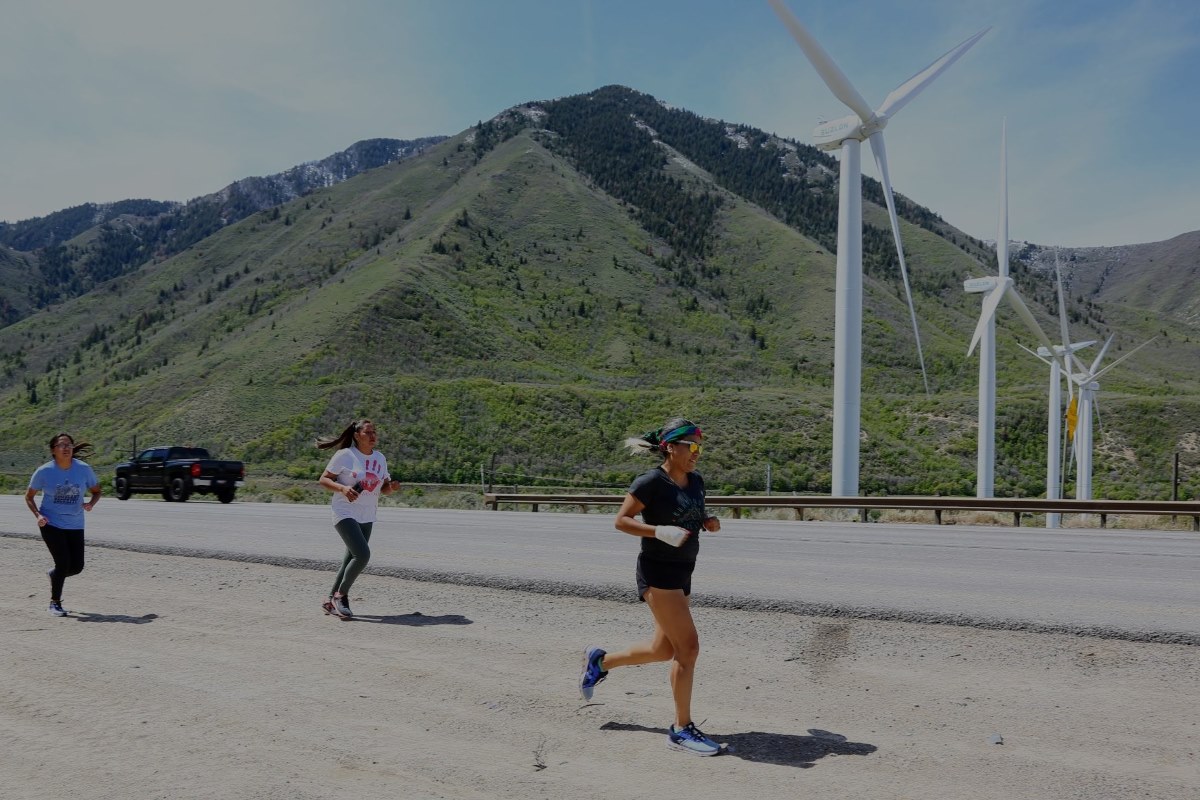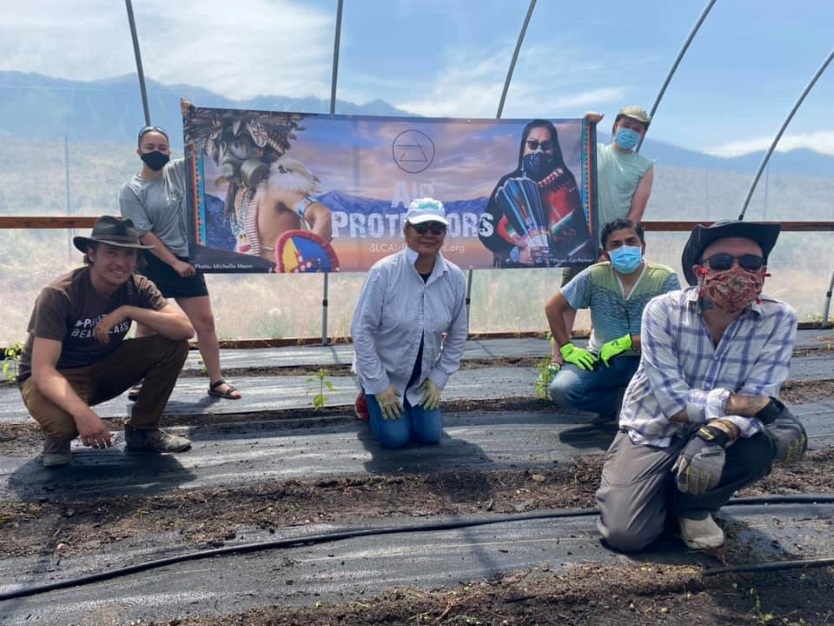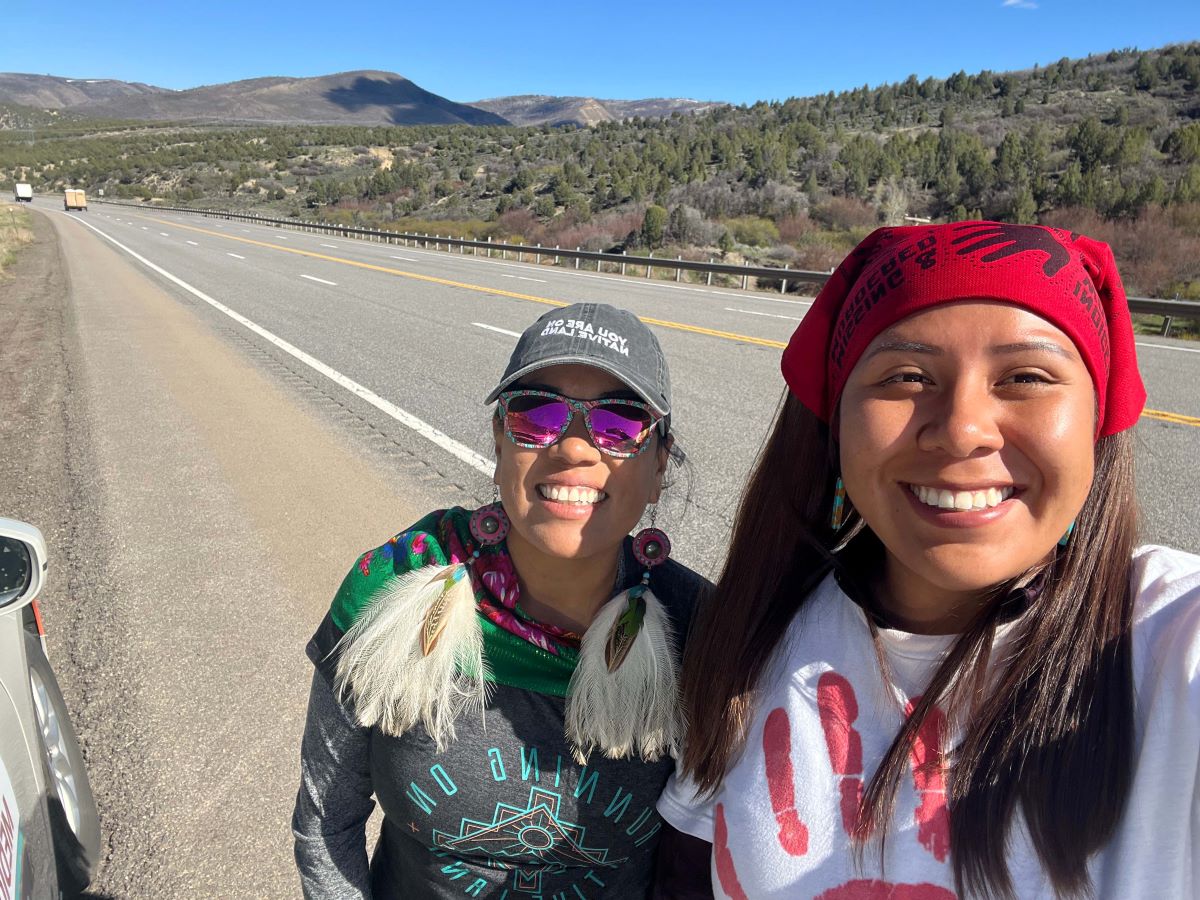The “guiding light” symbolic fire of the SLC Air Protectors, an Indigenous-led nonprofit that organizes the annual 360-mile Running as Medicine Prayer Run through Utah, was uncovered at the 2016 Standing Rock protest.
The founding board members met at the namesake reservation for the Lakota and Dakota nations, recalls L.J., the organization’s president, also known as Linda Jim. The 64-year-old Diné leader, lifelong runner, mom, and auntie grew up in the village of Bluff in San Juan County, Utah, and has lived in Salt Lake City, Utah, for five decades. Hundreds of protesters stood against the Dakota Access Pipeline, which was approved for construction that January, due to the transport of crude oil from North Dakota to South Dakota, Iowa, and Illinois, which jeopardizes the water supply as well as ancestral burial grounds.

L.J. of the SLC Air Protectors wearing her traditional headband. Photo: Robin Pendergrast/www.rfpphoto.com
“We wanted to go protect the clean water. While there, the elders told us that there was a lot of dirty air and unclean water in our community. When they lit that fire up there, they had an elder take care of the fire, and the tradition is to keep that physical fire lit. They instructed for us to go light that fire in our community,” says L.J., one of the inaugural members of the SLC Air Protectors, which offers a range of community programs that support clean air and water around Utah’s capital city of Salt Lake City. Following the fire ceremony, four of the six initial leaders have remained involved since 2017, including L.J., Alan Naumann, and Michael Kundick.
“I was raised to be involved in community service and to take care of Mother Earth. She is our mother and here for us, so in return, how can we help her? For SLC Air Protectors, it was good to bring non-Indigenous internally to train, teach, and ask, ‘How can we make this a better community?’” says L.J.

Runners coming in to Spanish Fork Canyon outside of Salt Lake City, Utah, on the Running as Medicine Prayer Run. Photo: Robin Pendergrast/www.rfpphoto.com
She adds, “I’ve never known skin color. We’re all here learning, exploring, it will take everyone, and it’s all of our responsibility. We are all here together, so let’s try to teach each other how to be better and take care of Mother Earth. There are lot of things I do not know, and here’s an opportunity to educate each other.”
On a personal scale, taking care of Mother Earth in an impactful way includes building simple, daily habits, says L.J.: “Turn off the lights when you leave a room. Don’t let water run when you aren’t using it. Use dish water as secondary water to water the plants and trees.”
One ongoing annual program of the SLC Air Protectors is the Garden Initiative: ten $200 micro grants are awarded to Utahns that have started, or wish to start, a personal garden. A second $2,000 grant is given to two tribal nations in Utah to build a community garden. The initiative represents the “backbone” of sustainability, because it supports local, grassroots, community-led solutions, explains L.J.

The SLC Air Protectors Garden Initiative in Ibapah, Utah. Photo courtesy of Linda Jim and Mary Paul.
“We extended that program to our relatives of the Shoshone-Bannock Tribes. We’d travel 3.5 hours, south of Wendover to Ibapah, [Utah,] to take shovels and tools, plant, put seed down, check the water system, and work to bring the tradition and history of Native American people — we survived by growing our own food — back for our elders. It brought a lot of memories back to the community, because the younger people had to move into the city to get an education and a decent job. The elders couldn’t do [that labor] anymore, so a lot of them would stop us, sing, and pray with us, and say thank you for seeing the garden area flourish again,” recalls L.J., who refers to all earthlings as relatives, because humans are all related in some way. She was raised with the lens that “we are meant to be close and to not be separate.”
The Running as Medicine Prayer Run began to help draw attention to the protection of Bears Ears National Monument in southeast Utah, which was rescinded in size by 85 percent in 2017. The protection was restored in October 2021. The region is home to more than 100,000 archaeological and cultural sites of ancient peoples across dozens of tribes who have lived there since time immemorial, according to the Bears Ears Inter-Tribal Coalition. Many Indigenous people still partake in regular ceremonies on — or gather from — the land. L.J. grew up 20 miles from the boundary. “I have a close connection with Bears Ears — that’s where my family, mom, and I would pick herbs, firewood, and pine nuts,” she shares.
At Standing Rock, “Our elders asked us to think seven generations ahead — not just tomorrow. We decided that, as Indigenous people, we would share a prayer through run. We are taught at a young age to run east to meet the good things in life before the sun comes up. I started at five years old with no shoes — to build endurance and a bond with Mother Nature. As you run, you carry a prayer from place to place: a prayer for who you are, your family, and something good,” she says.
In 2023, the fourth annual five-day Running as Medicine Prayer Run will be held from Bears Ears National Monument to Warm Springs Park in Salt Lake City. The last two blocks of the run are slow, so that children from the community can join. The program supports Indigenous runners of all ages, from teens to elders, through lodging, three meals per day, and team support.
“We want a combination of ages on a team because young kids can give us the energy, and elders can teach the young kids. I ran, too, and I drove the support van,” says L.J. Each morning starts with a spiritual connection, prayer, and smudging with a spiritual advisor.
“Elders are the force and backbone. They’ve been through life and know to do the right thing and the correct way to do it. If it’s not done correctly, they express that. They are the caretakers of me and the runners. We rely on them for their wisdom,” says L.J.

L.J.’s sister, Mrs. Charlene Stash, taking part in the Running as Medicine Prayer Run. Photo: Robin Pendergrast/www.rfpphoto.com
To start, the conversional lessons begin on running and its purpose. In the middle of the journey, the dialogue shifts to the purpose of life, how time is spent, impact, and vision. The experience includes bonding through activities such as nutritious food, recovery hikes, circle groups, yoga, and spiritual education through mentorship and guidance on how to conduct yourself in a prayer run.
L.J. says, “As you are running, you are humbling yourself in prayer and bonding with Mother Nature. As a young lady, I was taught you need to be obedient and bring strength to yourself because there is a lot that will happen in your lifetime, and you have to have endurance. We don’t separate from our prayer from Mother Earth: It’s continuous. A way of life, because that is the only thing that will guide us.”
An application for the core participants will be shared via the SLC Air Protectors Facebook page 60 days before the run starts, and you can also find information on their Instagram account. The exact timeline differs every year according to the weather and the numbers involved: The run has previously been held in October and May when the temperatures are cooler.
Supporters of all backgrounds are invited to run for any duration alongside the Indigenous runners at any point of the journey.
Beyond her servant leadership, L.J. works full-time for a national dental insurance company, where she’s been an account and client consultant for 22 years. She plans to work for six more years before retirement, though she has started weaving more vacations into her calendar, including a trip to Hawai’i last year. She’s also a grandmother of three — the children of her 33-year-old son, Chance Willden.

L.J.’s grandchildren Crimson Sky Willden (foreground, in pink) and Knightley Sky Willden (background, in red) taking part in the Running as Medicine Prayer Run. Photo: Béésh Adee’ Photography/www.beeshadeephotography.pixieset.com
“This time in my life is for me to teach them their songs, dance, prayers, and traditions — to teach the things my mom taught me. Within Navajo tradition, it’s so important because everything is taught and passed on through oral history. There was no writing,” says L.J., who still runs — but not at 5 a.m. and not barefoot, she chuckles. She waits for those cold days to warm up, so she can enjoy an interval run outside on hills, or she runs on a treadmill. Her grandkids — Penelope, nine; Crimson, six; Knightley, four — all meet her and the team for the closing two blocks of the Running as Medicine Prayer Run.
“We’re doing it for the next generation,” L.J. says. “The other side of that is, if you have wisdom and knowledge, please pass that on because once you’re no longer here, where will that go?”
Call for Comments
- Have you heard of L.J. and the SLC Air Protectors before?
- Have you taken part in the Running as Medicine Prayer Run? Would you like to?

